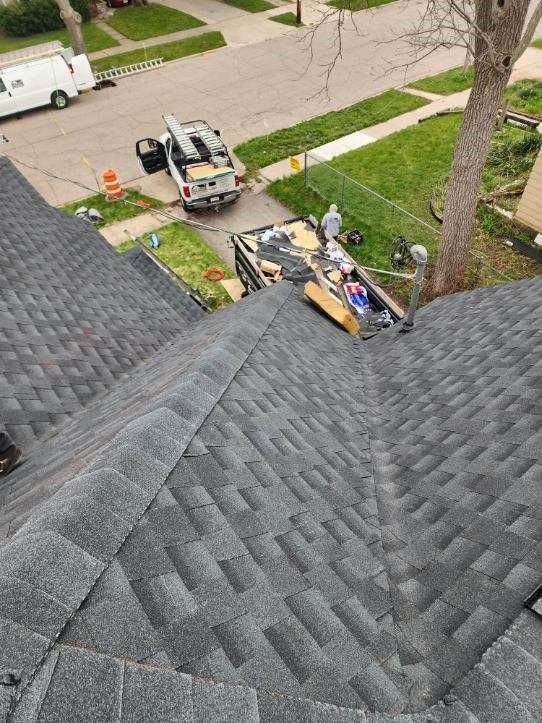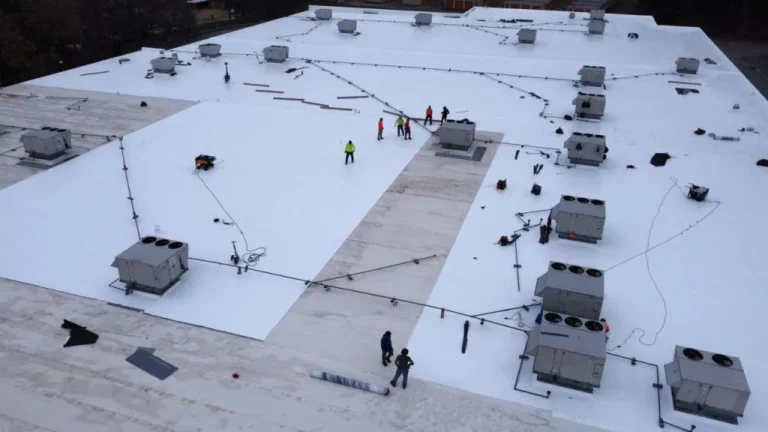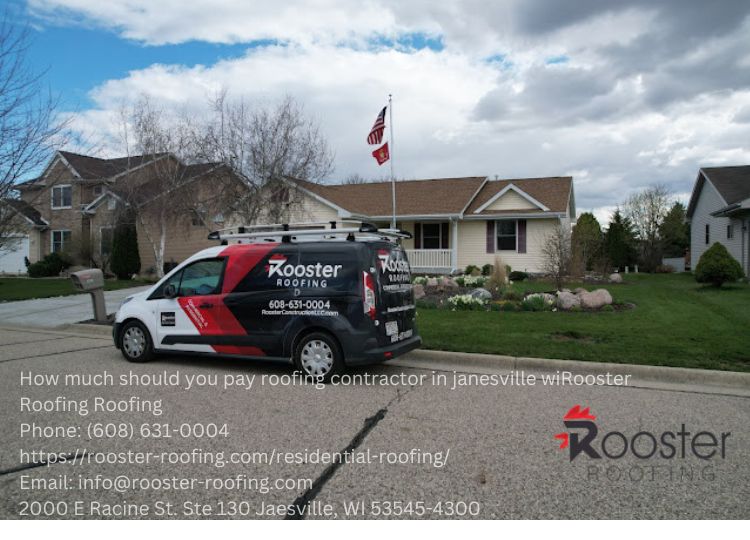What is the Best Time of Year to Replace a Roof in Wisconsin?
Thinking about getting a new roof for your home in Janesville, Edgerton, Beloit, Evansville, Brodhead, Milton, Monroe, Madison, Delavan, Lake Geneva, or any of our other wonderful Wisconsin communities? That’s a smart move! Your roof is super important – it protects your whole home from Wisconsin’s wild weather. But here’s a secret from your friends at Rooster Roofing: timing is everything when it comes to a roof replacement.
You see, unlike places with milder weather, Wisconsin throws everything at your roof: average yearly snowfall in Madison often goes over 40 inches, we get freezing winters, and our summers can be hot and humid. Choosing the wrong time for your roofing project could lead to delays, higher costs, or even damage to your home in the long run. So, let’s explore the best time to replace your roof and help you plan for a smooth and cost-effective installation.
At Rooster Roofing, we’re not just experts in residential roofing and roof replacement; we also handle commercial roofing, roof repair, roofing installation, roof maintenance, gutter installation, and siding installation. We know Wisconsin weather inside and out, and we’re here to help you make the best decision for your home.

Why Timing Matters So Much for Your Roof (and Your Wallet!)
You might think, “A roof is a roof, why does the season matter?” Well, it matters a lot! Here’s why your roof replacement timeline is a big deal:
- Weather affects materials: Take asphalt shingles, for example. They need just the right temperature range to seal properly. If it’s too hot, they can get soft and easily scuffed when nailed down. If it’s too cold, they become brittle and might crack. The sweet spot for installing asphalt shingles is usually between 40 and 85 degrees Fahrenheit.
- Labor costs and availability change: Just like how everyone wants to go on holiday at the same time, everyone often wants their roof replaced in the peak seasons. This means roofing companies get booked up fast, and prices can go up due to high demand.
- Delaying can cause bigger problems: A small leak you notice in spring could turn into a huge headache with major interior damage by winter. Addressing issues promptly can save you time and money. Waiting too long is considered the biggest mistake homeowners make, as insurers might even deny coverage if additional damage occurs due to lack of maintenance.
A well-timed roof replacement not only makes sure your new roof lasts a long time but can also save you money and hassle.
The “Goldilocks” Temperature for Your Roof
As we mentioned, asphalt shingles are very popular, and they really like temperatures that are “just right.” The ideal range for installing them is usually between 40 and 85 degrees Fahrenheit. This isn’t just good for the shingles; it’s also more comfortable for the roofing crew, helping them work quickly and efficiently.
Now, let’s look at the different seasons and what each one brings to the table for your roof replacement project.
A Season-by-Season Look at Roof Replacement
Each season in Wisconsin has its own pros and cons for getting a new roof.
Spring (March – May): The Season of Renewal
Spring feels like a fresh start, right? It’s often the first chance for homeowners to check for any damage caused by winter.
Pros:
- Comfortable working temperatures: Once the snow melts and temperatures become more stable, conditions are excellent for roofing crews.
- Better availability: Contractors often have more open schedules in spring compared to the super-busy summer months.
- Early problem detection: Doing a spring inspection can help you spot any winter damage early on, before it gets worse. It’s a great “spring-cleaning” milestone.
Cons:
- Rain delays: Wisconsin springs are famous for rain and melting snow, which can cause delays or make tearing off the old roof tricky.
- Lingering cold: Early spring (even March and April) can still bring freezing temperatures that can stop asphalt shingles from sealing properly. Below 40 degrees Fahrenheit is often too cold for shingles to adhere well.
- Best for: Homeowners who want to get ahead of the peak season rush and have some flexibility in their schedule.
Summer (June – August): The Busiest Time
Summer is the busiest season for roofing in Wisconsin, and it’s easy to see why.
Pros:
- Ideal for shingles: Warm temperatures help shingles seal quickly, giving you watertight protection fast.
- Fast installation times: Long daylight hours and dry conditions allow crews to work very efficiently.
- Low risk of weather delays: Generally, there are fewer rainy days than in spring or autumn.
Cons:
- High demand = higher costs: Because contractors are super busy in summer, prices can be higher.
- Competitive booking: You might have to wait several weeks if you don’t book your project early. In fact, Angi’s data shows May and June had fewer bookings of the warmer months, suggesting booking earlier could be beneficial.
- Extreme heat: Roof temperatures can reach over 49°C (120°F), which means there are limits to how many hours crews can safely work on certain days.
- Best for: Homeowners who want quick, efficient installations and are able to book their project 4–6 weeks in advance.
Fall (September – November): The Sweet Spot
Many roofing experts, including the team at Rooster Roofing , agree that fall is the absolute best time of year for a roof replacement in Wisconsin.
Pros:
- Optimal shingle performance: Temperatures usually in the 10°C–20°C (50s–70s°F) range help shingles set perfectly without getting too hot. Lower humidity also helps with shingle adhesion.
- Prepare before winter: Getting a new roof in fall means better insulation and protection for your home before the snow season arrives.
- Contractors are still active: Roofing companies are usually working at full capacity through much of the autumn.
Cons:
- Shorter days: Less daylight means projects might take a bit longer.
- Risk of early snow: Especially in northern or rural parts of Wisconsin, snow can sometimes hit as early as late October.
- Booking can be competitive: Since it’s a popular time, you might need to plan ahead to secure your appointment.
- Best for: Homeowners who want the perfect balance of good weather, contractor availability, and long-term durability for their roof. September and October often offer the best mix of dry weather, cool temperatures, and contractor availability.
Winter (December – February): A Tricky Time
While not ideal, roof replacements can be done during Wisconsin’s winter, especially if it’s an emergency. However, snow, ice, and cold temperatures bring several challenges.
Pros:
- Flexible scheduling: Contractors generally have more availability during the colder months.
- Off-season discounts: You might be able to get better pricing during this slower season.
- Emergency service: If you have a serious roof issue, you don’t have to wait until spring to get it fixed.
Cons:
- Material performance issues: Asphalt shingles may not seal properly in temperatures below 4°C (40°F). Cold can make them brittle and prone to cracking. The tar sealant on shingles won’t activate without a heat source.
- Dangerous conditions: Ice and snow greatly increase safety risks for roofing crews.
- Longer project timelines: Snowfall and freezing temperatures can pause work for days at a time.
- Best for: Emergency replacements or projects using materials that handle cold weather well, like metal roofs.
What About Different Roofing Materials?
Your choice of roofing material can definitely influence the best time to install your new roof.
- Asphalt Shingles: Best installed from Spring to Fall, as they need temperatures above 4°C (40°F) to seal correctly.
- Metal Roofing: This material is much more flexible! It can be installed all seasons, even in winter, because it’s less affected by temperature fluctuations.
- Cedar Shakes: Generally best from Spring to Fall, as they can be susceptible to moisture during installation.
- Synthetic Shingles: Also typically best from Spring to Fall.
Other roof types, such as most commercial roofing projects, are generally not as affected by the weather as much as asphalt shingles. Rooster Roofing has experience with all these materials, whether you need a commercial roofing solution or a new roof for your home in Janesville!
Emergency Roof Replacement: Don’t Wait!
While fall is often considered the best time for a planned roof replacement, if you have an emergency, do not wait!. An emergency usually means your roof has been seriously damaged by a storm, or it’s leaking and causing water damage inside your home.
Waiting for the “perfect” season in these situations could lead to much more severe damage to your home, and your insurance company might even deny coverage if they see it as a lack of maintenance. At Rooster Roofing, we understand that sometimes you just can’t wait. We offer emergency roof repair services to help you navigate these urgent situations.
What Time of Year is the Cheapest to Replace a Roof? (And Why “Cheapest” Isn’t Always Best!)
Okay, let’s talk about saving money. A new roof is a big investment, and it’s natural to look for ways to make it more affordable.
Generally, winter is usually the cheapest time of year to replace your roof. This is because winter is the slowest time for roofing companies due to the challenging weather. With reduced demand, contractors often have more availability and may offer lower or more competitive prices to keep their crews busy. You might even find off-season discounts.
However, here’s a really important point from us at Rooster Roofing: while looking for an affordable time of year is smart, you should never simply look for the cheapest possible price for your roof replacement.
Why not? Because looking for the absolute cheapest option can lead to serious problems down the road:
- You get what you pay for in quality: A cheaper price often means cheaper labor, cheaper materials, and crucial components (like drip edge) might even be left out to cut costs. This sets your roof up for failure much sooner than it should.
- Your investment won’t be maximized: A quality asphalt roof should last 20-30 years. If you choose the cheapest installation, corners might be cut, or incorrect techniques used, which means even good materials could fail early. You want your roof to stay leak-free for as long as possible.
- You won’t get the best warranties: Good roofs come with two types of warranties: one from the contractor on their workmanship and one from the manufacturer on the materials. If you go for the cheapest option, you’ll likely miss out on enhanced warranties, and even material warranties might be voided due to improper installation. A cheap contractor might only offer a very short workmanship warranty (like 2-5 years) because they know problems are likely to pop up later.
- You’ll pay more in the long run: That cheap roof will likely have problems sooner rather than later. When this happens, you’ll have to pay out of your own pocket for repairs or even another full roof replacement much sooner than you should have. A cheap roof replacement can bring stress, frustration, and end up costing you more of your hard-earned money over time.
So, while winter might offer potential cost savings, it’s crucial to weigh those against the challenges of cold weather and ensure you’re still working with an experienced, reputable contractor who can handle those conditions.
At Rooster Roofing, we believe in providing quality work that protects your home and maximizes your investment, even if it means a slightly higher upfront cost.
Rooster Roofing: Your Local Experts for Every Season
Whether you’re in Janesville, Edgerton, Beloit, Evansville, Brodhead, Milton, Monroe, Madison, Delavan, Lake Geneva, or any of our surrounding areas in Wisconsin, Rooster Roofing has helped countless homeowners navigate the process of roof replacement. We understand the unique challenges our local climate presents and know what works best, and when.
Our experienced team knows the “tricks of the trade” to ensure a quality roof replacement, no matter the season. We’re committed to making the process as easy as possible for you.
Ready to Plan Your Roof Replacement?
Choosing the best time to replace your roof in Wisconsin depends on many things: your roof’s current condition, the type of materials you’re using, your budget, and of course, the ever-unpredictable Wisconsin weather! Planning ahead is key, but remember, an emergency means you shouldn’t wait.
At Rooster Roofing, we’re here to help you make the right choice for your home in Janesville, Edgerton, Beloit, Evansville, Brodhead, Milton, Monroe, Madison, Delavan, Lake Geneva, and beyond. Whether you need help after a storm, or your roof is simply getting old and needs replacing, contact us today to get started! We’ll help you through the process, answer all your questions, and ensure you get a high-quality roof that protects your home for years to come.










